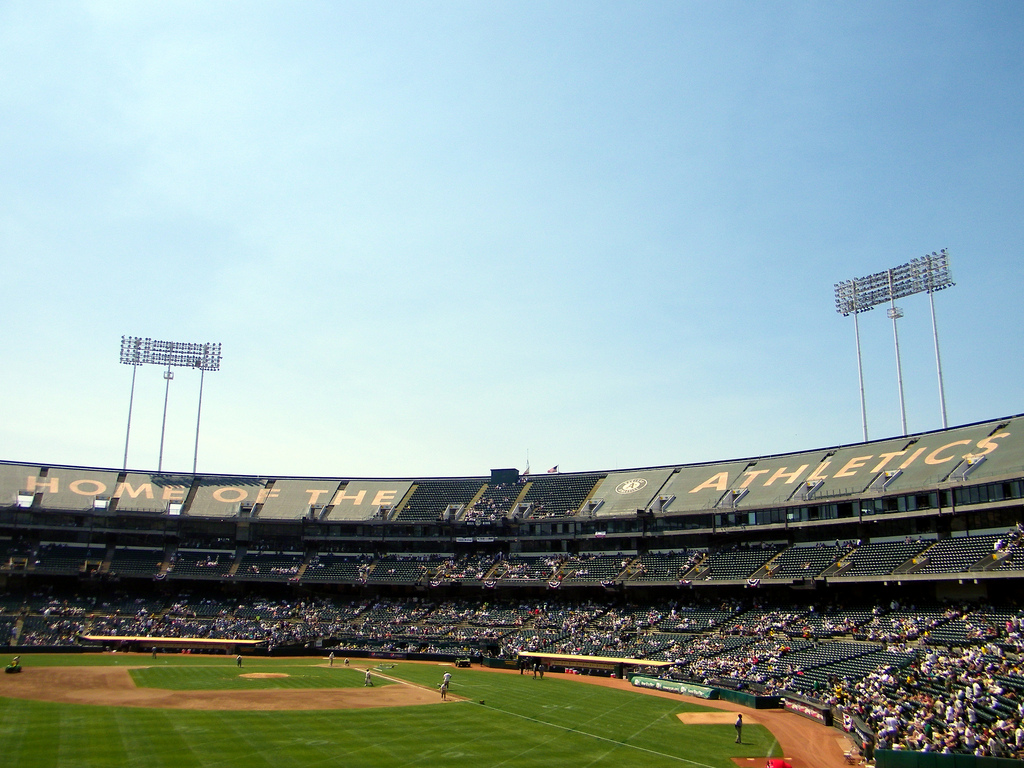
“What a dump,” says Brad Pitt near the end of the 2011 film Moneyball, channeling his inner Bette Davis. Pitt is talking about the Oakland Alameda County Coliseum, home stadium of baseball’s Oakland Athletics. (It’s now known as the O.co Coliseum as part of a rebranding by the online retailer known as Overstock.com)
Moneyball is set a decade ago, and, when you consider America’s passion for sports and for building new stadiums in which to watch them, you might think the dumpy Coliseum, by 2013, would be a goner. But this month, the A’s opened their season there.
The A’s aren’t happy about being stuck in a dump. Team officials talk about the place the way you might discuss an old uncle who can’t take care of himself. They say the Coliseum has constant daily problems (cables, pipes, concrete cracks) and lacks the electrical capacity to do the things a modern ballpark must do. And so the A’s have spent more than a decade trying to find a way to build a new stadium, which the team considers an absolute necessity.
That point of view is understandable, but there’s another way to look at the endurance of the Coliseum: as a peculiar civic triumph.
California is now home to three of the five oldest stadiums in Major League Baseball: Dodger Stadium in Los Angeles (1962), Angel Stadium in Anaheim (1966), and the O.co Coliseum, Brad Pitt’s favorite dump (also 1966). (Only two Progressive Era national treasures, Wrigley Field in Chicago and Fenway Park in Boston, are older). The state also boasts three of the five oldest National Football League stadiums (though the San Francisco 49ers are getting a brand new park in Santa Clara in 2014). Since California is a place known more for reinvention than cherishing the past, the endurance of our stadiums represents a considerable achievement—and it says something encouraging about our state.
People like to say that California and its governments spend too much. But these ballparks put the lie to that notion. Yes, in salaries and benefits for certain public employees, we are spendthrifts. But those are the exceptions. Overall, the state is frugal—downright miserly, even. That’s unwise when it comes to funding schools and roads. But it’s wise in matters of stadiums.
One of the few things that economists agree upon is that stadiums are almost always terrible public investments. They consume large amounts of land for which there are more productive uses, and they relocate economic activity from other areas but produce little that is new. The buildings are also worth less than the sum of their parts. The San Diego Padres’ beautiful but taxpayer-funded Petco Park, a hiccup for this new-stadium-starved state, cost more than $400 million to build but was valued by Forbes last month at just $103 million. Fortunately, San Diego’s football Chargers still play in the old ballpark, Qualcomm Stadium, and have struggled to get a stadium.
Meanwhile, being a state of cheapskates hasn’t cost us on the field. The Dodgers and Angels are highly competitive, and the A’s won last year’s American League West championship. Indeed, the A’s, succeeding while being cash-strapped, may be as good a model as any for what California has to be in this era—smarter and harder-working, because we don’t have the money of the Yankees or Wall Street to paper over our mistakes.
Of course, we shouldn’t neglect upkeep on stadium infrastructure that is truly outdated. But we seem to be going all right on that front. When I dropped by the Coliseum on a recent weekday morning, I saw cracks in the concrete but also workmen fixing up the place. Many were doing electrical work in preparation for the new season. A crane lifted advertising banners onto the side of the building. Best of all, even amid the decrepitude, scores of devoted fans were lined up to buy tickets, looking as eager as a bunch of kids trying to get into a fading but still cool dive bar.
The scene reminded me of the context in which Brad Pitt’s “what a dump” line takes place. Pitt’s character, general manager Billy Beane, has just turned down a lucrative offer from the Boston Red Sox. His statement conveys frustration over his working conditions—and a resigned affection for the ratty old place.
Eleven years later, Beane is still working at the Coliseum. And Californians should join him at the ballpark as much as we can, so that we, all together, can cherish another season in the dumps.




Send A Letter To the Editors